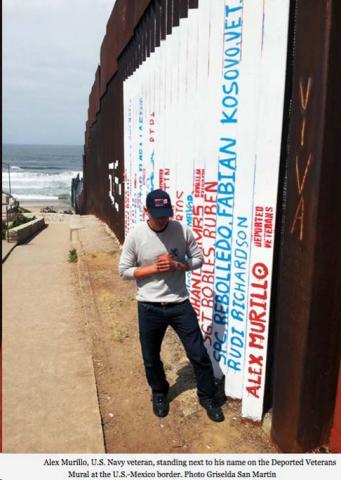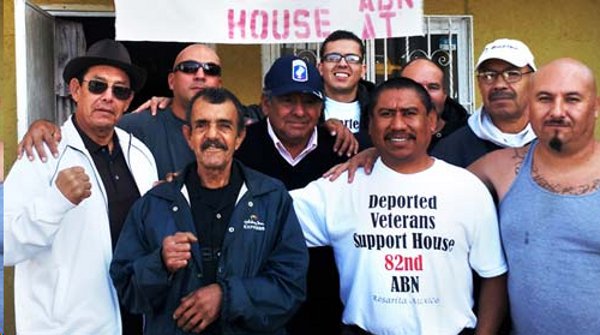Deported U.S. Veterans Design Artwork on Border Wall

From New America Media and El Tecolote:
Editor's Note: One of the amendments to the Senate's immigration reform bill (Richard Blumenthal, D-Conn.) would allow DREAMers who enroll in the military to become U.S. citizens. But for veterans who already have been charged with a crime and deported, it may be too late. Now a group of deported vets is building a community and creating their own mural on the U.S.-Mexico border.
When Alex Murillo was released at the U.S.-Mexico border right outside of Tijuana in 2011, he was given a little money, a cup of soup and was allowed to make a single phone call.
“They released me like a baboon into the wild,” said Murillo, 35.
His deportation was scheduled for noon, yet it was nearly midnight when he crossed into his country of birth and realized that he had nowhere to go.
The U.S. Navy veteran felt abandoned by the government for which he had risked his life for nearly four years, and that was now forcing him to leave behind his five children.
Murillo is one of thousands of veterans who have been charged with a crime and deported. There are no solid figures on how many veterans currently share Murillo’s predicament, and Immigration and Customs Enforcement (ICE) does not provide numbers.
It is estimated that about 70,000 U.S. residents served in the U.S. military between 1999 and 2008. Deported veterans are not eligible for VA Benefits.
“The faces that are being deported aren’t just brown or Latino—they are deporting them all over the world,” said Amos Gregory, a San Francisco-based artist, activist and U.S. Navy veteran. “They are broke, in a foreign land, traumatized—and of course they have criminal records.”
Growing up in a war zone
Along with a group of about 12 deported veterans currently living near the border, Gregory designed a mural to draw attention to the cause.
Painted on the border fence, it depicts an upside down image of the American flag—a universal sign of distress. The names of deported veterans are being added to the mural.
“Most of these deported veterans grew up in America’s war zones: the streets. Many of them saw the military as a way out, only to be sent into a real war,” said Gregory, explaining that the veterans’ criminal histories are often affected by Post Traumatic Stress Disorder (PTSD) and are substance abuse issues.
“When they come back, they are suffering from their experiences.”
Murillo joined the Navy in 1996 after high school, hoping to be exposed to things greater than the gang violence that he grew up with in his neighborhood in Phoenix, AZ. With his first son, Alex Jr., on the way, Murillo was also facing the responsibility of providing for his new family.

“I had a thing for getting out and seeing the world a little bit,” said Murillo. “I wanted to do something good. I wanted to get some school out of it.”
After having served most of his time, the airframes and hydraulics mechanic returned home from a six-month deployment on an aircraft carrier to a dissolving marriage.
“The military is a drinking community, everybody around me drank. When I found out my marriage was ending, I got into trouble,” said Murillo, who was kicked out of the Navy in 2000 for bad conduct, shortly before his enlistment was up. “I was already out the door, and after being so good for so long—that really hurt. What I really needed at the time was some help.”
Murillo faced difficulties integrating into life after the military. Unable to pay child support, he said desperation forced him to take a job that he should not have taken. He said he was busted with a substantial amount of marijuana and sentenced to three years in federal prison. It was at this point that he realized that he did not have U.S. citizenship.
“When I joined the navy, I thought getting your citizenship was automatic. Putting on that uniform meant something to me—it should mean something,” said Murillo. “All of those guys, I hear that they were told that if they take that oath they will be Americans. There was no other country to think about.”
Broken promises
Fabian Rebolledo dropped out of college and signed up for the Army after a recruiter promised him citizenship following his enlistment.
“I was doing everything I could to get in,” said Rebolledo, who immigrated to the U.S. at the age of 13 from Mexico. “They never mentioned to me that there are certain processes to follow while in the military to obtain citizenship.”
After serving in Kosovo in 1999, the paratrooper completed his enlistment in 2000, believing that he was already a U.S. citizen. Four years later, Rebolledo received a letter in the mail requiring renewal of his resident card.
Rebolledo had a run-in with the law after being charged with fraud for cashing a $750 check, but fought the case and was given probation. He was later detained and deported for driving with a suspended license.
“I’m originally from Mexico, but I don’t know my country,” said Rebolledo, who was forced to sleep on the streets of Tijuana for three days following his deportation. “I felt humiliated by the United States for throwing me out and letting me be on the streets like a real criminal—I’m not a criminal.”
Veterans Support House offers refuge
Rebolledo and Murillo have not given up on the hope of one day returning to the United States. In the meantime, they organized in a support group called Banished Veterans Support Group, founded by deported Army veteran Hector Barajas.
The group operates out of a two-bedroom apartment, called the U.S. Deported Veterans Support House, located in Rosarito, Mexico. They support deported veterans by communicating with their families, picking them up at the border, and providing them with shelter, food, and clothing.
“We recently found a veteran living in the streets—he was sleeping in an empty parking lot,” said Rebolledo. “We brought him to the house. We don’t want a single one of us to be living on the streets anymore.”































































































































































































































































































































